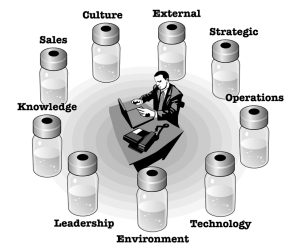I was poking around Wikipedia, reading about “Formula for Change” created by Richard Beckhard and David Gleicher. I am curious how much applicability there is to ANTIGENcy in these models…and vice versa.
They created a model to help evaluate the propensity for an organization to change. It looks like this:
D x V x F > R
Three factors must be present for meaningful organizational change to take place. These factors are:
D = Dissatisfaction with how things are now;
V = Vision of what is possible;
F = First, concrete steps that can be taken towards the vision.
If the product of these three factors is greater than
R = Resistance,
then change is possible. Because of the multiplication of D, V and F, if any one is absent or low, then the product will be low and therefore not capable of overcoming the resistance.
To ensure a successful change it is necessary to use influence and strategic thinking in order to create vision and identify those crucial, early steps towards it. In addition, the organization must recognize and accept the dissatisfaction that exists by communicating industry trends, leadership ideas, best practice and competitive analysis to identify the necessity for change.
What this allows managers to do is to isolate the actual problem areas of change and develop unique strategies specifically designed to resolve the correct form of resistance.
Okay. So what this means is that given most organizations, like most people, have a hard time seeing introspectively, they are most likely to not change.
I like how this begins to isolate individual parts of resistance so they can be addresses “atomically” and all the players and pieces can enjoy more transparency.
I think every organization I have ever been with, worked for or against, had massive difficulty seeing and feeling the dissatisfaction. It is about admitting something. Like an alcholic admitting they have an important issue, they aren’t likely to.
The second variable, the vision of what’s possible, is the easy part. Who cannot see something better? This feels like table stakes.
The third variable is precisely what ANTIGENcy is about. Being able to isolate the specific challenges or friction an organization feels and doing something about it. Especially with respect to internal cultural dynamics.
In any case, I like how this formula helps people who know change is necessary see the possibility deconstructed.
If you are a CEO and your org’s performance isn’t what it should be, know that there will be ample resistance if you have the willingness to start change. I’ve been there and sludged through it. It isn’t pretty but for each time I have walked through the “tunnel of change, ” I learned to embrace the resistance and understand it from all angles before taking that first step.
